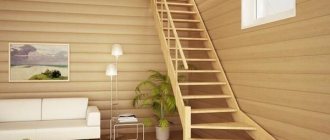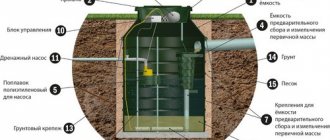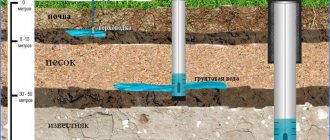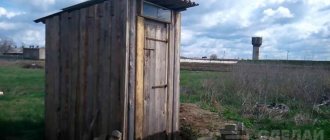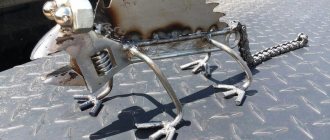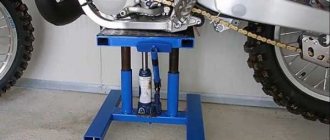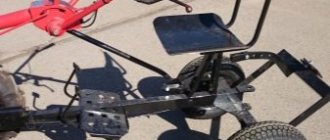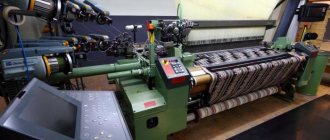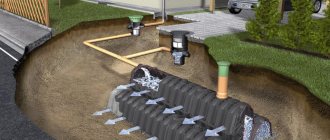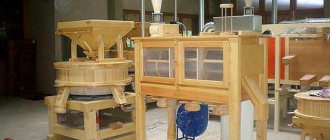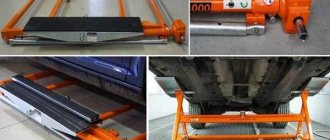Calculator
An easy way to find out the cost in a minute.
Application received!
The manager will call you to clarify details within 20 minutes.
The approximate cost of the stairs is 0 per meter of ascent
. Fill out the application to receive an accurate estimate by email:
By clicking the "" button, you agree to the data processing policy.
0 per meter of lift
approximate turnkey cost
Read more
steps
Cladding 40 mm thick from elite “Extra” wood, which is famous for its clean structure without knots. Customers choose one of five types of wood based on their budget and desired wood grain. The steps are dried and glued properly, which means they can withstand loads at any point and last for decades.
Pine
For a summer house, bathhouse, garage Subject to rapid wear Density 500 kg/m3
from 16,405 per meter of lift
Larch
For wet rooms Medium density rock, 570 kg/m3
from 24,650 per meter of lift
Beech
For houses with room humidity and temperature Density 670 kg/m3
from 32,810 per meter of lift
Ash
Premium breed Resistance to impacts, scratches Density 690 kg/m3
from 49,300 per meter of lift
Oak
Premium breed Maximum strength Density 750 kg/m3
from 52,360 per meter of lift
Why do you need a metal staircase
There are plenty of materials for constructing stairs, but metal is popular for the following reasons:
Wrought iron staircase
- It is reliable and designed for a long period of use, which means you don’t have to worry about the next repair after 5 years or creaky steps that won’t give you rest after a couple of years.
- Metal can withstand heavy loads, so you don’t have to worry about this issue, which is not at all relevant for wooden structures. The reliability and strength of the staircase is dictated not only by the material, but also by proper design, but if metal is in the balance, then few can compete with it.
- Very strong connections. The staircase consists of several elements, and if the material is chosen ill-considered, the structure will soon begin to crumble. This will not happen with metal connections.
- You will have a huge choice in a variety of shapes and models. Metal as a material allows you to create masterpieces that no one has ever created before. And this is an excellent opportunity for those who want to express and reflect their style in the interior, and not just think through the practical component.
- During the construction process, you can divide the work on the stairs into two stages. Yes, this is possible with metal structures. You can make the initial frame, and it will already withstand the entire load. At this time, you are engaged in finishing work, and then proceed to the final finishing and decoration. Convenient when the budget requires additional savings.
- Metal steps do not creak. Wood, even the highest quality, can sooner or later creak. If you do the repairs on time, which in itself is already an extra expense and time, it still does not guarantee that the creaking will not appear elsewhere on the stairs. This will never happen with a metal structure - it cannot creak.
- Use of additional finishing materials. Metal goes well with other materials, and even if you don’t want this material to be clearly visible (this happens depending on the style), decorative elements made from other materials fit in well.
Advantages of metal frames
For houses made of all materials
Suitable for construction in country houses from timber (taking into account shrinkage), aerated concrete, SIP panels, brick, monolith.
Installation at any stage
Possibility of installing the frame and steps in two stages at any stage of construction. Use during “dirty” work without the risk of damaging the cladding.
Silence
No friction between the metal and the steps, unlike solid wood stairs, which will quickly dry out and creak under load.
Withstand loads of 700 kg
The reinforced all-welded assembly gives the structure stability, strength and high load-bearing capacity.
Durability
Immunity to changes in temperature and humidity thanks to multi-stage processing and protective coating.
Wooden staircase on a metal frame
There are several types of such structures. The staircase frame is made of metal, and the steps are made of wood. The model is an open frame type with two stringers. As a rule, railings are installed in steel or aluminum. This model often has no risers, which gives the structure a light, airy look. This solution is widely used in techno or high-tech interiors.
Magnetic holders for welding.
A channel placed on its edge is the basis of a simple staircase. Wooden or sheet material is suitable for covering the stairs. The steps are sheathed with non-slip corrugated metal. Fences are made of angle steel.
We place cut fillets from reinforcement on the channel. The dimensions and required number of fillies can be taken from the calculation documentation.
Since the steps will lie on the fillies, we weld the mounting brackets to them.
We assemble the entire structure together by welding the parts. If, after installing the fillies on the first channel, deviations are visible on the second, correct the markings. To fasten a simple ladder, a pair of stringers or bowstrings will be enough.
Prime the stairs with primer and let it dry. Afterwards we apply a special anti-corrosion compound to the stairs.
The function of support or the so-called frame of the staircase will be performed by an additional stand, which can be made of a channel to which the staircase is welded using corners. During all welding work, you can use magnetic welding holders; this will greatly simplify the work of both an experienced and a novice welder. They can withstand loads from 11 to 34 kg, depending on the model. You can choose something for yourself from this list of magnetic holders.
After completing the assembly, you can begin covering the structure.
Video on building an iron staircase
To carry out installation, stationary preparation will be required, as well as precisely designed drawings. The steps can be fastened both from below and from the end.
Stages of work
Calculation
The specialist will tell you everything about the future staircase and advise on technical issues. After communication, he will prepare preliminary calculations.
Metering
The engineer will take measurements and advise on the design and location of the staircase so that it is comfortable, compact and appealing in appearance. Particular attention is paid to the location of communications, the readiness of finishing, and base materials.
Project
The project will be developed on the basis of convenience formulas, all norms and standards. It will include information about the structural components, including balusters and handrails. A computer model will help you understand what kind of staircase you will get as a result.
Frame
The metal frame of the stairs will be assembled and painted at the factory. Installation of one span will take 2-4 hours.
Facing
The steps will be made from high-quality dried and glued wood. The painter will tint them in the chosen color and apply a double layer of varnish. Craftsmen will install the cladding on the base.
Features of metal structures
Based on the manufacturing method, two types can be distinguished: a staircase designed entirely from metal, and a staircase built on metal frames. Both are perfect for use in frame houses for lifting to the second floor.
metal bowstring
Staircases are also distinguished by the number of flights: one- and two-span, with a turn and straight. But if you are building a staircase for the first time, then it is better to start with a single-flight option.
The peculiarity of any project is reflected in drawings and calculations, which indicate:
- Slope of steps.
- Height and width of steps.
- Placement of steps.
The depth of the steps for a metal staircase should not be less than 27 cm. This is due to the fact that when descending from the stairs, there is a danger of falling. The height of the step should be from 16 to 20 cm. If it is higher than the specified norm, then there is a large load on the knees and it is uncomfortable to use such a ladder.
DIY metal stairs have a number of advantages:
- Durability of the metal staircase structure (for example, cracks appear on a wooden staircase after just six months of use).
- Possibility of combination.
- Structural strength.
- Low cost of frame installation.
staircase calculation
DIY outdoor metal staircase
The process of making an iron staircase for the street requires experience, knowledge and skills in working with metal structures. If you have not previously encountered such work, then making an external metal staircase with your own hands will be difficult. After all, looking at projects on the Internet is not enough; you need to know what all the symbols mean and at least approximately understand the intricacies of installing such products. But it’s okay, now you will find out everything.
Drawing up a project for an external staircase and calculating dimensions
Before proceeding directly to creating the structure, try to carefully draw up a project for the external staircase, make a drawing, and prepare all the materials that will be required during the work process.
Video: rules for drawing up a project (drawing) of a staircase
To avoid problems during operation in the future, it is necessary to calculate the dimensions of all parts in such a way that quality and safety do not suffer for the sake of a stylish appearance. Sometimes it is very difficult to combine a design idea with existing standards.
Video: how to calculate stairs
Making an outdoor metal staircase with your own hands
If you are determined to make an outdoor metal staircase with your own hands, first prepare the metal, a welding machine and other auxiliary tools that may be needed during the work process.
An excellent choice for making steps would be reinforcement rods, which will be welded to the base at a certain interval. In our country, the use of such elements is especially important, because in winter precipitation will not accumulate on its surface, which will avoid “ice”. In addition, such steps are easy to clean from dirt. However, do not forget that during operation, the external staircase to the attic or second floor of the house must be regularly treated with a special anti-corrosion coating.
As a base for reinforcing bars, it is best to use a regular metal profile - a channel mounted on an edge. It is to them that, by welding, the so-called “fillies” are attached, acting as a support for the steps.
For those who are not satisfied with the option with rods, there is a wide choice of other, no less attractive solutions. For example, perforated and embossed steps will prevent slipping. You should not use materials with smooth surfaces, otherwise throughout the winter, when climbing the external stairs to the second floor, you will be forced to frantically cling to the railings so as not to fall.
To obtain a durable and reliable structure, all connections must be made by welding. And only properly executed seams will give you complete confidence that it is safe to move along these stairs.
Railings and railings for outdoor metal stairs
We must not forget about such important elements as railings and fences for external metal stairs. They ensure the safe operation of the product and create an original appearance.
As a rule, handrails made of wood or PVC are installed on stairs. But there are cases when bare metal is left, for example, on forged products. The gaps in the railings are filled with posts or shields.
After installing the external staircase, be sure to sand down all the irregularities and welds using an emery wheel (grinder). Cover the product with primer or paint. This will help keep the metal in good condition.
Making a staircase from a profile pipe to the second floor with your own hands
Reliable DIY wooden staircase for a porch master class Video and step-by-step instructions
For the manufacture of stairs on a metal frame, profile pipes with section dimensions of 40x60 mm are used, which will provide the structure with sufficient strength.
There are two methods for assembling the frame. You can make the entire frame outside the installation site and then move it directly to the place where the stairs will be located. This method may not always be suitable, since the structure is quite heavy and you will have to resort to the help of special mechanisms. And the finished structure may not fit into the existing openings in terms of dimensions.
Installation of a factory-made modular staircase is easy to do yourself
Experts recommend making the frame directly at the installation site of the stairs to the second floor. In this case, mistakes made can be corrected as work progresses on site.
Cutting blanks
Work begins with choosing a staircase design: in this case it will be a stringer design. A staircase diagram is being developed with all the necessary dimensions and taking into account the location of the turning steps. The diagram will be needed throughout the manufacture and installation of the stairs.
Scheme of a modular staircase on a ridge stringer
Profile pipes are pre-cleaned of scale. In accordance with the scheme, work is carried out to prepare elements of the required size and quantity.
Making your own stairs on a metal frame is possible if the design is simple and you have the skills to work with a welding machine and metal
In order for the work to go faster, it is recommended to first prepare and cut all the elements, and then start welding. But gradual cutting as the work progresses allows you to make fewer mistakes. The choice is yours. Pipe cutting is carried out while maintaining all angles.
Installation of load-bearing supports
Once all the elements are cut, the supporting beams of the frame are installed. The number of beams should be equal to the number of stringers. The supporting channel is cut so that its cut plane rests against the ceiling beam and the floor. In some cases, the base is prepared and the channel is welded to it.
Spacious rotary staircase with landing
At this stage, an important condition is the correct and parallel installation of the channels (if there are several of them). The correctness of the entire structure will depend on their location. If you are planning a rotating system, you must first make the necessary rotation of the load-bearing beam according to your design. If the diagram provides for a structure with a platform, then the ends of the flight supports must rest against the platform and be securely fixed.
Blanks for steps
Blanks for steps are made in the shape of a triangle, into which the steps are subsequently laid. To secure these triangles, a spot stitch is used in several places. Check the correctness of fastening and only after that securely fix it by welding to the main frame. Bolts are also used as fasteners.
Marching rotary staircase on a metal stringer
When the first blank for the step is ready, a temporary step from the board is laid on it, then all the following “kerchiefs” are gradually installed.
Making a frame for a 90-degree rotating staircase is much more difficult. The sizes of triangular blanks will vary. Here it is recommended to prepare each element only after the previous one has been installed.
Spiral staircase on a metal frame
Sometimes, when using a wide channel as a load-bearing element, instead of triangular blanks for steps, metal stands for them are welded to the base.
Metal frame processing
After installation, begin cleaning the seams. The entire metal surface of the frame is processed: degreasing, applying anti-rust compounds, priming. Next, the metal is coated with paint. If a stainless steel profile was used, no processing is needed.
Metal staircase in the style of "minimalism"
The steps for the stairs can be made of wood or metal. A more exotic option is stone or glass. If wood acts as steps, the shelves of the triangular corners should be at the bottom; if it is stone or concrete, the shelves should be directed upwards.
The main advantage of stairs with a metal frame is the ability to combine different materials in a wide variety of combinations. At the same time, stairs with a metal frame are strong, durable and can match any interior style.
Manufacturing process of a metal staircase
Preparatory stage
Before proceeding directly to the manufacture of a metal staircase, it is important to think in advance about its design, the number of flights, steps, design, shape and much more. Based on this, you can calculate the required amount of materials and tools for the job.
The simplest design of a metal staircase, consisting of a supporting frame made of a channel or wide pipe. The channels are installed in the form of stringers, and then metal steps are welded to them parallel to the floor.
- To make such a single-flight staircase, you will need two channels of the same length or a rectangular electric-welded pipe about 80 cm wide, a square steel pipe, as well as metal corners, smooth steel with slots for steps, a primer for metal, welding electrodes, welding or grinding discs, etc. .
- Useful tools include a drill, grinder, welding machine, protective mask or goggles, pencil, tape measure, etc. When everything you need is ready, you can move on to the process of constructing a metal staircase.
Main works
The process of creating a metal staircase begins with the manufacture of a frame.
- To do this, take channels of a given length, place them on an edge and, using electric arc welding, weld corners or “fillies” that will act as a base for the steps.
- Metal steps made of smooth steel with slots or any other material, such as wood or glass, will be mounted on top of them. The main thing is to maintain right angles, so that the steps are parallel to the floor surface.
- Next, the railings and fences are made from a square metal pipe, after which they are secured in place using the same welding.
- At the end of all the work, the ladder is installed in a pre-prepared opening and securely secured with anchor bolts.
If it is necessary to make a staircase in several flights or with intermediate platforms, then it is worth noting that they must be placed on vertical supports or attached to the walls.
Finishing
The manufacture of a metal staircase frame and its installation is not the entire scope of work. Finishing is of great importance, which is designed to provide reliable protection of the finished structure from metal corrosion, as well as give it a finished appearance.
At this stage of work, it is necessary to carry out final processing of all welds, as well as protruding parts, any roughness and sharp corners. To do this, we use a grinder with an emery wheel and thoroughly clean everything.
- Next, we will carry out anti-corrosion treatment of all metal surfaces. First, they are degreased, then treated with a special compound or rust converter, after which a metal primer is applied to the dry surface.
- The final stage is the decoration of the stairs. Here you can use various options for original finishing, for example, elements of artistic forging, wooden railings, unusual painting, etc. It all depends on the tastes of the owners of the house, as well as the interior of the room, if it is an internal staircase, or the architecture of the building, if the staircase is located on the street.
You can learn more about how to make a metal staircase yourself in the video:
